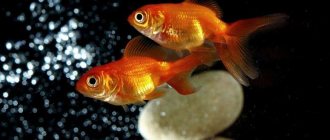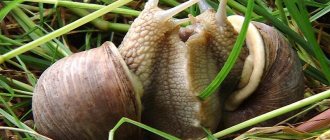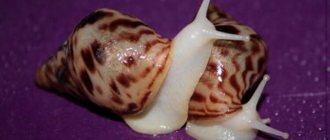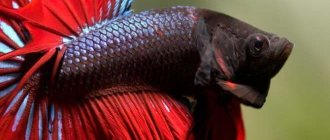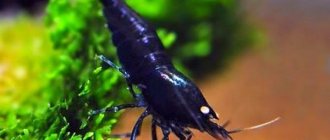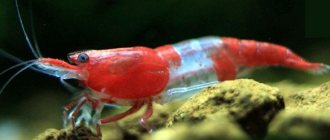Happy couple, female Mac Snow het Patternless, male Patternless. A very common question is how to determine the gender of a leopard gecko, how to distinguish a male from a female? How to see sexual characteristics in adolescent leopard geckos?
Let us recall that basically the gender of the leopard gecko depends on the temperature and, accordingly, the time of incubation of the eggs, but leopard geckos with the Albino gene can, as they say, fail, and even with very precise maintenance of the temperature and incubation time, “unforeseen” males among females and females are possible among males.
How to determine the sex of a leopard gecko
Adult leopard geckos have several distinctive sexual characteristics. First of all, you need to pay attention to the undertail part of the body. In males, an arc of yellowish-gray dots is visible in front of the cloaca, located from one hind paw to the other - the preanal pores. At the base of the tail behind the cloacal slit it is easy to notice protruding bumps. This is where the hemipenis, the male copulatory organ, is located. In females there is a triangle in the lower abdomen, it is faintly visible. They have no pineal formations.
Also, leopard geckos of different sexes can be distinguished by the shape of the base of the tail. In males it is thick and wide, in females it is thin, resembling a waist, followed by a bushy tail. However, this sign is reliable only if the lizards have a varied, nutritious diet, which allows them to accumulate nutritional reserves in the tail part of the body. Otherwise, the thickness of the base of the tail does not matter.
Priming
It is better to keep the juveniles on plain paper, at least until they are 10-12 cm long.
Leopard geckos are very active when feeding, and can often swallow soil while catching insects.
And in juveniles this leads to digestive problems and even death, since their intestinal lumen is much narrower than that of adults. However, you can feed them in a separate container, as in the video below.
As for sand for adults, opinions are divided: some are quite comfortable keeping geckos in the sand, others say that it is dangerous.
Apparently, the issue is the size of the sand grains; it is important to use very fine sand, 0.5 mm or less. But, if you are still concerned about your health, then pebbles, moss, special rugs for reptiles and paper are quite suitable
At what age can the sex of a leopard gecko be determined?
The sex of a leopard gecko can be determined starting from 4 months. By this time, males have developed all sexual characteristics. The same cannot be said about females - they are not physiologically ready for childbearing. Their fertile age occurs after a year. Therefore, it is better to keep teenage leopard geckos separately from females to avoid fights and injury.
The sex of reptiles is directly affected by the temperature of the eggs in the incubator, so by adjusting it yourself, there is a high probability of getting offspring of the desired sex.
In newborn animals, you can try to determine the sex using a flashlight (Rob Wagner's method). To do this, it is necessary to highlight the cloaca area. In males, the veins of the hemipenes should be visible in the light.
Pet care
Leopard geckos need air humidity for easy molting. These lizards shed periodically. First, the lizard's body fades and then becomes completely white. When the head also becomes white, the leopard geckos begin to tear off their old skin. New, bright skin is visible underneath.
It leads a nocturnal and twilight lifestyle, hiding during the day under stones and in caves.
Thanks to the moist air, this process proceeds without problems, and no dried pieces of old skin remain on the bodies. If even a tiny piece remains on the body, it should be immediately removed with tweezers, moistened with warm water, otherwise the lizard may develop a skin disease. But treating skin problems in leopard geckos is not at all easy.
In terms of health, care should be taken with these reptiles
The terrarium should have a drinking bowl with clean water, which is changed every 2 days. Leopard geckos love to drink a lot, and at the same time they lap up the water with their tongue, the word cats. These lizards are very clean, so they only go to the toilet in a certain part of the terrarium. The area should be cleaned regularly, removing feces and adding new pebbles.
Reptile feces should be brown and not runny. When upset, leopard geckos are given enterosgel. If the medicine does not help, you will need to consult a veterinarian, as these lizards have a very sensitive stomach and intestines. They may even experience rectal prolapse, and if surgery is not performed, the animal may die.
Matching
When selecting a pair for breeding leopard geckos, it is necessary to take into account the genetic compatibility of their morphs. Using a special calculator, you can determine the expected color when crossing different morphs, and also find out whether they are suitable for each other. Genetic incompatibility can lead not only to undesirable lizard colors and disappointment, but also to unhealthy babies.
Attention!
In addition to genetic compatibility, the quality of the offspring is also influenced by the health status of their parents. Only mature, adult, well-nourished, healthy animals are suitable for breeding leopard geckos.
The optimal individuals for mating are lizards that are at least 1 year old. And although males are ready for insemination from 4-6 months of age, a female can safely carry a pregnancy only from the age of one year with a body weight of at least 45 grams. Theoretically, she can get pregnant earlier, but such early sexual activity will lead to the birth of an unhealthy offspring. Moreover, the health of a young lizard can suffer greatly due to exhaustion of the body, even to the point of death.
Even an adult lizard may not be ready to mate. Given the high sexual activity of persistent male leopard geckos, real bloody battles can occur between the pair. Therefore, creatures of different sexes should be kept in different enclosures. Depending on the temperament of the male gecko, he may need up to 5 females to satisfy his reproductive instinct.
Only healthy, sexually mature, well-nourished individuals can participate in breeding leopard geckos.
Home maintenance
The leopard gecko is clean, which is very good for families with small children; you won’t have to often force the children to clean the aquarium.
They themselves determine the location of the toilet (usually in the corner), and only go there. By the way, clean animals rarely cause allergies, including leopard geckos. Characteristics of the reptile:
- Lifestyle – nocturnal;
- Body length – up to 30 cm (usually up to 20);
- The color is very diverse, from yellow to brown, about 100 colors in total. A spotted leopard pattern is a must;
- Life expectancy is up to 20 years.
The size and lifespan directly depend on the conditions of detention. In general terms, they are unpretentious, but you must try to comply with two conditions:
- Large spacious aquarium or terrarium;
- High humidity.
Spotted leopard gecko
Looking at the photo, its thick tail immediately catches your eye. There they store supplies of water, as they naturally live in the hot deserts of Afghanistan, Pakistan and parts of Iran.
In its place, of course, a new one will grow, but already thin, like that of ordinary lizards.
As for its character, the spotted leopard gecko is a very calm, balanced animal, and although it is not very smart, it becomes quite attached to a person and is happy to bask in its arms. They don't bite, so you can let children play, but warn them about the tail.
Terrarium
Not only the size and life expectancy of the reptile, but even the growth rate depends on the size and contents of the terrarium (or aquarium). Recommended dimensions are at least 50x40 cm with low walls. Volume – about 50 liters.
Terrarium for a lizard
It is very important to recreate the usual conditions inside the aquarium, but only by excluding sand. There should be a lot of ledges, snags and caves so that the lizard does not get bored, and it can explore its territory every day and hide during the day
It is useful to install a weak heater at the bottom of the aquarium so that the air inside is about 30 degrees during the day and about 25 at night. Also spray the inside of the terrarium with a spray bottle several times a day so that the humidity is around 45%.
Either one individual or a group of one male and several females (up to ten) can be kept in one terrarium. Male and male do not get along; the only way to keep them together is in a huge terrarium so that they can distribute territories.
Creating suitable conditions for reproduction
Before the breeding season, it is advisable for the geckos to rest and gain strength during hibernation. This is what happens in nature: after wintering, the reproductive instinct awakens in animals. After suspended animation, males become active suitors, and females become more friendly. Lizards gain new nutrients with renewed vigor, eating well and preparing for fertilization, pregnancy and egg laying. At this time, it is worth taking care of the device in which they will be incubated.
DIY incubator
Without additional equipment, it will not be possible to incubate leopard gecko eggs. In order for the babies to hatch successfully, it is necessary to maintain a certain degree of humidity and temperature. Even the sex of future lizards depends on temperature indicators.
If it is not possible to purchase a special incubator in a store, you can build the device yourself. For this you need the following components:
- large transparent container with a lid, volume 30-40 l;
- aquarium heating element with thermostat;
- fine mesh stainless steel mesh or cutlery tray;
- small plastic containers that will hold the eggs;
- suction cup thermometer;
- drill, set of plastic clamps.
A large container is filled 1/3 with water. Then they make holes in the upper part of it and use them to attach the tray inside the container. If a fine-mesh mesh is used, then mini-shelves are placed on the walls of the container with glue, and the mesh is laid on them. It will serve as a stand for small containers in which eggs will lie. Such stands should be 1-2 cm above the main water level. Holes are made in the lid of the future incubator for aeration.
The heating element is placed at the bottom of the homemade device, making sure that it does not touch anything. Set the desired temperature and attach the thermometer above the water level. After 6 hours, check the thermometer readings with the heating device. If they differ, then adjust the heating level until they reach the desired values.
Vermiculite, perlite, and 3-5 cm of coconut fibers are placed in small containers in which the masonry will be located. Holes are also made in the lids. It is important to monitor condensation inside the incubator. Any contact with water will destroy the gecko eggs.
Professional equipment is better quality and more reliable
Features of feeding
The basis for successful breeding of leopard geckos is a balanced diet. Their diet should be dominated by insects and vitamins. Keeping crickets that will be eaten should be accompanied by a saturation of vitamins and proteins. To do this, they are fed minced meat a day before they are eaten by lizards.
Carrying and laying eggs requires a lot of effort, effort and energy, so calcium supplements and vitamin D3 must be present in the diet of females. One-day-old mice, which are given a couple of times a month, will also be useful for them. However, you should not overdo it with protein nutrition. It can lead to obesity and suppressed fertility.
Attention!
Often during the breeding season, leopard geckos refuse to eat. Don't worry about this - this is normal behavior during this period.
Bringing a couple together
Separate keeping of opposite-sex reptiles in separate terrariums for geckos serves as an excellent incentive for successful mating. Therefore, it is better for reptiles to winter in different tanks. The male should be kept in the dwelling in which copulation will then take place.
The female is placed with the male for 7-10 days. If she is ready for intercourse, then the mating process occurs immediately. If she is not ready, the female may begin to bite her partner and a fight will break out between the couple. In this case, it is better to seat the reptiles for a while. After a couple of weeks, you can try again.
If the male is too temperamental, you can try to connect the pair on female territory. There, the black leopard gecko or other gecko species will feel insecure and behave more modestly. In this case, there is a possibility that the copulation process will be successful.
Usually the female is placed with the male during the breeding season of leopard geckos for about a week
Courtship process
When a female appears in her mating home, the male begins to vibrate his tail. At this time, you can hear a cracking sound. Sensing a female nearby, the gentleman begins to gently bite the tip of his partner’s tail, gradually transferring such “kisses” from the tail along the back to the neck.
If the lady is ready for copulation and accepts his advances, she stands motionless with her tail raised. At this moment, holding the skin of the neck in his mouth, the male performs copulation. The act lasts 2-3 minutes. If the female is not ready, then she moves aside. To ensure fertilization is likely, it is best to mate geckos several times during the mating season.
Pregnancy
After successful fertilization, eggs begin to grow in pairs in the female’s stomach. They can be seen through the translucent skin of the lizard. The first pair of eggs usually takes a long time to grow (3-6 weeks). The rest ripen every two weeks. During one copulation of leopard geckos, all the eggs that the female must lay during the season (2-9 pairs) are fertilized.
During pregnancy, it is important for the expectant mother to get proper rest, eat healthy and varied, and additionally receive calcium-containing vitamins. By the end of pregnancy, the female’s abdomen becomes voluminous and sinks to the bottom, her appetite disappears, and the reptile more often hides in shelters.
During pregnancy, females begin to feed heavily and eat calcium
Laying eggs
After fertilization, 3-4 weeks must pass for the eggs to be ready for birth. Two days before laying, the lizard searches for a suitable place where it will lay them: it digs moss and substrate in a damp chamber, hangs around in the terrarium, putting things in order. It is important to ensure that the moss does not dry out, because the female will bury her eggs in it.
The process of laying eggs most often occurs in the dark - at night or at dawn. The female digs in the clutch and does not leave it for some time. At first the eggs are sticky and moist, then they dry out and may stick to each other or the substrate.
During the mating season, the female carries 4-6 clutches. In order not to ruin the lizard’s health and not get a painful litter, it is best not to allow it to make more than 4 clutches. To do this, reduce daylight hours and lower the temperature in the terrarium.
Otherwise, the reptile’s body is depleted, and the quality of the young noticeably drops.
Most often, the female lays eggs at night or early in the morning.
Incubation of eggs
Often there are unfertilized eggs (wen) in the clutch, so before incubation of the eggs begins, they are examined for the presence of a leopard gecko embryo. To do this, strictly in the position in which they are after laying, it is necessary to illuminate them from below with a flashlight. A fertilized egg will have a pink spot (embryo) and brown blood streaks visible. When exposed to light, wen are usually completely yellow-greenish in color.
Attachment of the embryo to the wall of the egg occurs quickly, so they should never be turned over, otherwise the future lizard will choke. Mark the top of the egg with a marker and carefully transfer it to a pre-prepared small container with substrate, having previously made a hole in it. The filler should not cover the eggs more than halfway.
Attention!
The container with the future offspring is placed in an incubator, marking the laying date on it with a marker.
Be sure to monitor the temperature and humidity, add water to the substrate weekly, and never touch the egg. The incubation temperature depends on the individual sex to be obtained:
- from 29.5 to 32.5 degrees, “boys” will be born within 40-55 days;
- from 26 – 28.5 – “girls” will hatch within 55-70 days;
- from 28.5-29.5 you are likely to get both female and male specimens.
Significant temperature deviations from the norm (below 25 and above 35) will ruin the embryo.
As the embryo grows, the egg will also grow. Gradually, its color turns from white to pink, and just before hatching, perspiration appears on the shell. Then the lizards peck the shell with their noses and are born.
Incubation of eggs is the most crucial moment when breeding leopard geckos.
The appearance of cubs
Typically, baby leopard geckos hatch on their own by breaking through the egg with their muzzle. But it also happens that the cub needs help. If it starts to hatch but doesn't get out within a day, gently open the egg with your fingers.
For some time, the newborn leopard gecko should be left in the incubator, and then placed in a separate container, in which a drinking bowl, a humid chamber and heating will await it.
In the first 2-3 days, before the first molt, the babies do not need to be fed. And then, when the leopard geckos have changed their skin, it’s time to offer them a few small crickets per feeding.
Breeding leopard geckos at home may seem like a complicated and very troublesome process. But it's worth it. The appearance of healthy and active cubs will compensate for all your efforts!
Reasons why the leopard gecko does not reproduce
Often, novice breeders' first attempts to breed pets are unsuccessful. There are several reasons why lizards do not reproduce.
Ovulation cycles
One of the main reasons for the failure of leopard geckos to reproduce is the lack of ovulation in the female. Until the ovulatory process begins, the lizard will not be able to become pregnant. A non-ovulating female will not allow her partner to approach her, and attempts to mate them will, at best, end in separation in different corners.
Sexual maturity of females occurs at 8-12 months with the appearance of the ovulation cycle, which corresponds to the seasonal breeding periods of leopard geckos from January to July.
To determine whether a lizard is ovulating, you need to look at its belly. If the process is ongoing, then you can notice a pink dot, which indicates that the egg in the female’s body has formed and is ready for fertilization. After successful mating, it descends to the lower abdomen to the right or left, where it turns into a full-fledged egg.
A female leopard gecko can lay 80-100 eggs in her lifetime
Men's problems
There are situations when males are not ready to mate with a partner, even if they are left alone during her ovulation period. There is no scientific explanation for this; the reptile does not want to show sexual activity. It is better to wait a while and try again later.
A male interested in copulation can be recognized by his shaking tail, like a rattlesnake. If this does not happen, then he will not mate.
Health problems
Even an ovulating female may have some health problems and during mating will reject the male’s advances. The natural instinct of self-preservation protects the lizard from reproduction if it is not ready. For example, she is not well-nourished, has not gained the required weight, or has not fully reached childbearing age. If a lizard with poor health is left alone with an aggressive male, there is a high risk of losing the animal. Therefore, in the case when she is not ready and refuses copulation, it is better to separate the pair.
Wrong mating time selected
Under natural conditions, the mating season of leopard geckos begins in January and ends in June. Peak breeding occurs in February-March. If you place a couple together outside of this period, the likelihood that mating will occur is almost zero.
The females of many reptiles are able to reproduce for the rest of their lives. However, the sexual activity of leopard geckos begins to fade after 5 years and by the age of 9 the females become completely infertile. Therefore, the older the individual, the less likely it is to be successfully fertilized.
If the breeder chooses the wrong mating time, the couple will behave aggressively towards each other. Or copulation will last a long time, and the female, tired, may move away from her partner. She will also not let him near her if fertilized eggs are already developing inside her.
The breeding season of leopard geckos is preceded by hibernation.
Terrarium
To begin with, it is worth noting that there are two main methods of keeping leopard geckos:
Horizontal terrariums for reptiles
Terrarium
They have a more aesthetic appearance; through the glass you can observe the life of your pet; you can place various decorations and plants in it. With proper care, such a biome will be an excellent addition to your interior, which you can show to friends - plus, the leopard gecko will feel more comfortable in it. What is needed is the horizontal one, because Leopard geckos love to climb on the backgrounds on the walls, without which no such structure is usually complete, and if the terrarium is at a high altitude, they can simply fall and injure themselves.
Cage keeping
Cage system from Exo Cube
The method used by most large breeders. It is a rack with trays of various sizes. Typically, on one side of such a rack there is a heating element (mat, cord, heated floor, etc.). This method allows you to keep a large number of animals in small areas.
Minimum size of living space for one leopard gecko: 30x30x30cm For two or three leopard geckos, the area will be sufficient: 50x30x30cm It is best to keep only females together, and for males to arrange a separate home, and place the females with the male only for mating.
For cage keeping, containers from Ikea with a capacity of 11 liters, called Samla, are suitable. Its dimensions: 39 x 28 x14 cm.
They will need to have flowing ventilation, and just like with a terrarium, arrange shelters (coconut house, wet chamber) and put a toilet napkin in the corner. The heating element is placed under the tray, just as in the case of a terrarium. Temperatures can be controlled with a small thermometer, for example a Chinese one from Aliexpress.
Why you can’t keep a leopard gecko in an aquarium
Many beginners periodically make the mistake of believing that the leopard gecko can be placed in a regular fish aquarium, covered with gauze or a perforated lid. And then they don’t understand why their pets developed fungus or other specific diseases. Mold may also appear in the aquarium - which does not happen with regular flow ventilation.
The point here is that drafts are extremely dangerous for terrarium reptiles, but constantly breathing stagnant air is no less harmful for them. In humid, stale air, snakes and lizards often develop fungal and bacterial diseases of the skin, respiratory tract, as well as problems with appetite and reproduction
Therefore, it is very important to take care of creating the correct ventilation system for your scaly pets. This rule applies to most reptiles kept in captivity.
Therefore, leopard geckos cannot be kept in aquariums.
To make the aquarium suitable for leopard geckos to live in, it is not enough to simply leave its upper part open; it must have proper ventilation. This is usually done with a drill: a number of holes are made along the bottom of the aquarium, sufficient for normal air circulation. But without experience working with glass, it is better not to experiment or engage in amateur activities; it is worth asking someone who understands this for help.
It is worth noting here that using a plastic container for 200 rubles, in which you can make holes with a regular soldering iron from a fixed price, will be more correct and less expensive, and the terrarium can be purchased later, now for 2000-3000 you can buy a normal terrarium for keeping 1-2 reptiles. For example, there is a wonderful workshop of terrariums “Three Dragons” from Semphiropol, which makes and delivers terrariums of any size throughout Russia at fairly reasonable prices, a workshop at the Reptoshop store in Moscow, and many others.
In the diagram you can see the location of the ventilation relative to the heating element.
Flow ventilation diagram
Tips and Tricks
There are several techniques to help a pair of leopard geckos get used to each other and carry out the process of sexual intercourse.
If an ovulating female refuses to mate, you can try to gradually introduce her to her partner's scent. To do this, take a piece of napkin located in the male’s terrarium and place it in the female’s enclosure. Over time, she will get used to the smell of a male and will become more friendly towards him when replanted.
Often males feel insecure when they are in a new tank and mating does not occur. To rectify the situation, you should try to meet the pair on male territory, or to meet the leopard geckos in a smaller container. The male is uncomfortable in a large space. The less space, the more comfortable he is.
Geckos should only be introduced facing each other. If you place a male right behind him, he will most likely bite his partner by the tail and receive a response bite from her.
Some females are not able to reproduce annually, so they experience breaks in childbearing. She needs rest to regain her strength and health.
In general, breeding spotted leopard geckos is accessible to any novice hobbyist.
Breeding leopard geckos is an exciting and promising activity that requires some preparation. To implement it, you must have at least basic knowledge about the content and seasonal life cycles of these unusual creatures; study color compatibility, matching morphs to get healthy offspring with interesting colors. The process of breeding leopard geckos is labor-intensive and time-consuming. If the breeder has these resources, then getting leopard geckos cubs is sure to be successful.
Did you learn something new? Share in the comments!
Courtship process
The male gently bites the female - the courtship process
The courtship process is beautiful. The male often vibrates the tip of his tail as he approaches the female (you may hear this sound). Then he begins to gently and often bite the skin on the tail, back and neck. If the female accepts the male's advances, she will not show any resistance; she raises and moves her tail to the side, allowing the male to mate with her. Not every such courtship is accompanied by mating; often the female simply moves a little to the side after such a “massage.”
Pairing. Even a single mating may be enough to produce offspring. If a male and female live in a terrarium together, then mating will be regular, especially in the evening. You can track this by the characteristic vibrating sounds from the male's tail.
Mating process of leopard geckos

